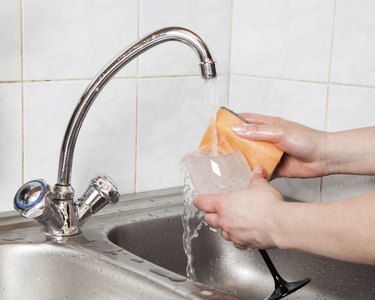
Instead of paying a company to customize wine glasses and other glassware, personalize your own pieces with paints. Stripes, dots, monograms and hand-painted images transform even the most basic glassware into a gift or a custom creation for your home. If you're painting on glassware that you plan to use, limit the paint to the outside of the glass and keep it well away from the rim so it doesn't come into contact with lips or beverages; the paint is not designed to be food-safe or edible.
Gleaming Glassware for Paint Perfection
Video of the Day
Wash the glassware in warm, soapy water as if you're hand-washing your usual drinking glasses. Soak the glass items for a while if they contain sticker residue that you could not remove easily with your fingernails. Scrape the residue with your fingernails again after soaking the glass to remove it completely. Dry the glass with a lint-free cloth; then wipe the areas you plan to paint with a soft cloth dipped in rubbing alcohol to remove fingerprints or greasy residues. Try not to touch the areas you wish to paint to prevent more fingerprints on the glass, or wear cotton gloves to remedy the potential problem.
Video of the Day
Picking the Paints
If painting on glassware that you plan to wash once in a while, a durable, lasting finish is key. Enamel craft paints, permanent glass paints and oil-based paint markers all adhere to thoroughly-cleaned glass. For a stained-glass effect, opt for translucent glass paints; otherwise, pick opaque paints for more solid, vivid painted designs. Enamel craft paints and glass paints may be applied with a brush, while, with paint markers, you can draw on the glass much if drawing on paper with regular permanent markers. No matter which type of paint you use, exercise caution when handling the glass item immediately afterwards; otherwise, you may smear your designs before the paint dries. Be sure to read the curing directions on your chosen paint product before purchase to ensure it meets your needs and expectations.
Crucial Curing
Painted glassware requires heat or a good bit of time to cure before the glassware can be used; some glass paints require 48 hours of curing time, while others may take several weeks. In some cases, baking the glassware cures the paint to a hard, durable finish, making it safe for hand-washing and the dishwasher. Place the glassware on a cookie sheet in the oven while the oven is cool; then heat the oven to 350 degrees Fahrenheit or the temperature recommended on the paint bottle. Bake the glass for 30 minutes or as recommended on the paint bottle; then allow it to cool in the oven. Do not wash or use the glassware for several days afterwards. If using paints with different baking recommendations, opt for the lowest temperature and shortest time.
Design Tips
Create simple designs such as stripes or chevrons using strips of narrow painter's tape to create boundaries for the paint. Turn thin tape strips into zebra stripes by scoring a wavy line on both straight sides of each strip, peeling away the excess tape to reveal a slightly irregular edge for the paint. Make your own stencils with contact paper or removable wall decals. With contact paper, cut out your designs with a craft knife. Apply either stick-on material by smoothing it on carefully to prevent bubbles. If painting designs freehand, sketch the idea in actual size on paper; then place the paper inside the glass, aligning the image so you can "trace" it on the outside of the glass item. Rest beverage glasses or glass vases sideways in a tray of dry beans or rice to prevent fatigue or awkward, uncomfortable hand positioning when painting heavily detailed images.